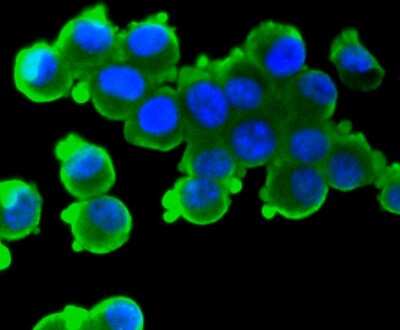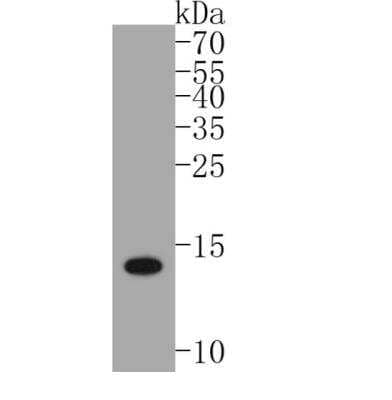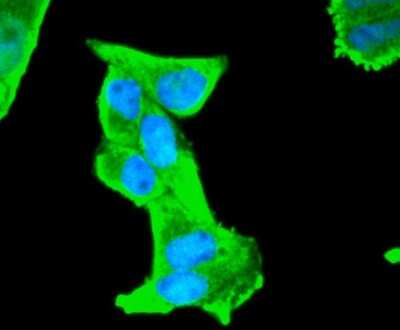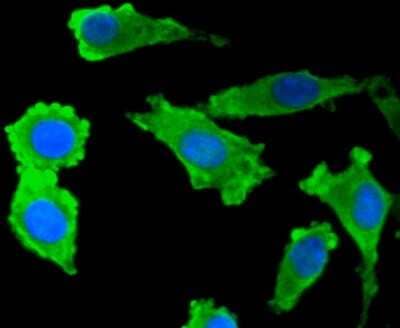S100B Antibody (SC57-02)
Novus Biologicals, part of Bio-Techne | Catalog # NBP2-67572
Recombinant Monoclonal Antibody.

Key Product Details
Species Reactivity
Human, Mouse, Rat, Goat, Zebrafish
Applications
Immunocytochemistry/ Immunofluorescence, Immunohistochemistry, Immunohistochemistry-Frozen, Immunohistochemistry-Paraffin, Immunoprecipitation, Western Blot
Label
Unconjugated
Antibody Source
Recombinant Monoclonal Rabbit IgG Clone # SC57-02
Concentration
1 mg/ml
Product Specifications
Immunogen
Synthetic peptide within C-terminal human S100B. (SwissProt: P04271 Human; SwissProt: P50114 Mouse; SwissProt: P04631 Rat)
Localization
Cytoplasm, Nucleus.
Clonality
Monoclonal
Host
Rabbit
Isotype
IgG
Scientific Data Images for S100B Antibody (SC57-02)
Western Blot: S100B Antibody (SC57-02) [NBP2-67572] - Analysis of S100 beta on mouse liver tissue lysates. Proteins were transferred to a PVDF membrane and blocked with 5% BSA in PBS for 1 hour at room temperature. The primary antibody (1/500) was used in 5% BSA at room temperature for 2 hours. Goat Anti-Rabbit IgG - HRP Secondary Antibody at 1:5,000 dilution was used for 1 hour at room temperature.
Immunocytochemistry/Immunofluorescence: S100B Antibody (SC57-02) [NBP2-67572] - Staining S100 beta in N2A cells (green). The nuclear counter stain is DAPI (blue). Cells were fixed in paraformaldehyde, permeabilised with 0.25% Triton X100/PBS.
Immunohistochemistry-Paraffin: S100B Antibody (SC57-02) [NBP2-67572] - Analysis of paraffin-embedded mouse brain tissue using anti-S100 beta antibody. Counter stained with hematoxylin.
Applications for S100B Antibody (SC57-02)
Application
Recommended Usage
Immunocytochemistry/ Immunofluorescence
1:50-1:200
Immunohistochemistry-Frozen
1:100
Immunohistochemistry-Paraffin
1:50-1:1000
Western Blot
1:1000-1:5000
Formulation, Preparation, and Storage
Purification
Protein A purified
Formulation
TBS (pH7.4), 0.05% BSA, 40% Glycerol
Preservative
0.05% Sodium Azide
Concentration
1 mg/ml
Shipping
The product is shipped with polar packs. Upon receipt, store it immediately at the temperature recommended below.
Stability & Storage
Store at 4C short term. Aliquot and store at -20C long term. Avoid freeze-thaw cycles.
Background: S100B
References
1. Yardan, T., Erenler, A. K., Baydin, A., Aydin, K., & Cokluk, C. (2011). Usefulness of S100B protein in neurological disorders. JPMA. The Journal of the Pakistan Medical Association, 61(3), 276-281.
2. Langeh, U., & Singh, S. (2021). Targeting S100B Protein as a Surrogate Biomarker and its Role in Various Neurological Disorders. Current neuropharmacology, 19(2), 265-277. https://doi.org/10.2174/1570159X18666200729100427
3. Thelin, E. P., Nelson, D. W., & Bellander, B. M. (2017). A review of the clinical utility of serum S100B protein levels in the assessment of traumatic brain injury. Acta neurochirurgica, 159(2), 209-225. https://doi.org/10.1007/s00701-016-3046-3
4. Wang, K. K., Yang, Z., Zhu, T., Shi, Y., Rubenstein, R., Tyndall, J. A., & Manley, G. T. (2018). An update on diagnostic and prognostic biomarkers for traumatic brain injury. Expert review of molecular diagnostics, 18(2), 165-180. https://doi.org/10.1080/14737159.2018.1428089
Long Name
S100 Calcium Binding Protein B
Alternate Names
beta (neural), NEF, S100, S100 beta, S100 calcium binding protein B, S100 calcium-binding protein B, S100 calcium-binding protein, beta (neural), S-100 calcium-binding protein, beta chain, 10protein S100-B, S-100 protein beta chain, S-100 protein subunit beta, S100beta
Gene Symbol
S100B
Additional S100B Products
Product Documents for S100B Antibody (SC57-02)
Product Specific Notices for S100B Antibody (SC57-02)
This product is for research use only and is not approved for use in humans or in clinical diagnosis. Primary Antibodies are guaranteed for 1 year from date of receipt.
